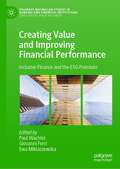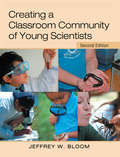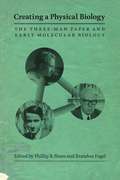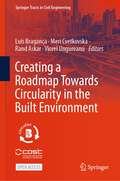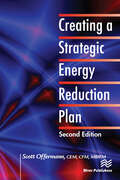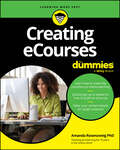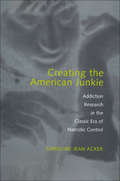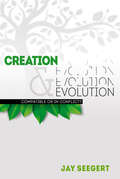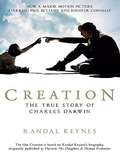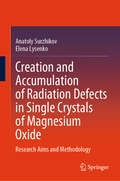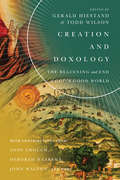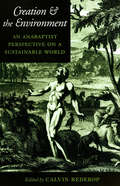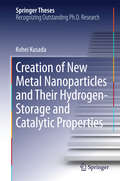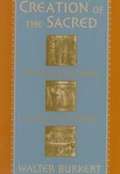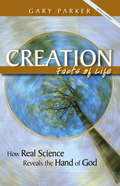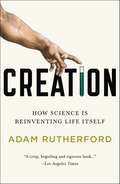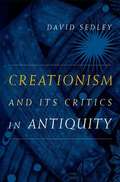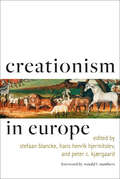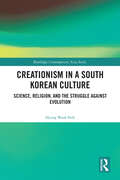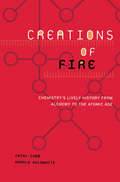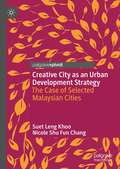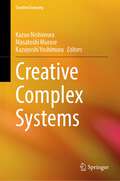- Table View
- List View
Creating Value and Improving Financial Performance: Inclusive Finance and the ESG Premium (Palgrave Macmillan Studies in Banking and Financial Institutions)
by Paul Wachtel Ewa Miklaszewska Giovanni FerriThis book discusses the transformation of the banking industry, particularly after a number of recent shocks: 2008 financial crisis, 2012 Euro-sovereign crisis, the pandemic COVID-19 crisis, the technological revolution, and reputational problems in banking due to climate risk and ESG (Environmental, Social and Governance) metrics.The book emphasizes two post-pandemic issues: the role of financial education and inclusive finance, and responsible banking and ESG priorities. Individual chapters analyse how the pandemic shed new light on social and governance responsibilities: Major issues include the importance and efficiency of financial education, and the impact of ESG programs on firms’ value, banks’ probability of default, bank business models and reputation risk. The book also addresses investors’ behaviour and the factors which may bias financial disclosure and reporting. By addressing whether the post-2008 crisis bank restructuring has effectively created a resilient and sustainable banking system – mostly from the European market’s perspective – the book will be of interest to researchers, academics, policy makers, and professionals of banking and financial institutions.
Creating a Classroom Community of Young Scientists
by Jeffrey W. BloomCreating a Classroom Community of Young Scientists helps teachers - both pre-service and in-service - to develop exciting science programs in their classrooms. This book provides the groundwork for designing and implementing a science program that takes into account the latest research in teaching and learning. It provides an approach that will capture children's imaginations, stimulate their curiosity and create a strong foundation for their continued interest in, and appreciation of, science and the world in which they live. The book is designed to be user-friendly, and offers an approach to teaching science that is exciting for teachers as well. This thoroughly revised, second edition focuses on making inquiry more explicit both in terms of the process of inquiry and teaching in ways that capitalize on children's curiosity and questions. New material has also been added on U.S. and Canadian science standards, as well as professional standards for teachers.
Creating a Physical Biology: The Three-Man Paper and Early Molecular Biology
by Phillip R. Sloan Brandon FogelIn 1935 geneticist Nikolai Timoféeff-Ressovsky, radiation physicist Karl G. Zimmer, and quantum physicist Max Delbrück published "On the Nature of Gene Mutation and Gene Structure," known subsequently as the "Three-Man Paper. " This seminal paper advanced work on the physical exploration of the structure of the gene through radiation physics and suggested ways in which physics could reveal definite information about gene structure, mutation, and action. Representing a new level of collaboration between physics and biology, it played an important role in the birth of the new field of molecular biology. The paper's results were popularized for a wide audience in the What is Life? lectures of physicist Erwin Schrödinger in 1944. Despite its historical impact on the biological sciences, the paper has remained largely inaccessible because it was only published in a short-lived German periodical. Creating a Physical Biology makes the Three Man Paper available in English for the first time. Brandon Fogel's translation is accompanied by an introductory essay by Fogel and Phillip Sloan and a set of essays by leading historians and philosophers of biology that explore the context, contents, and subsequent influence of the paper, as well as its importance for the wider philosophical analysis of biological reductionism.
Creating a Physical Biology: The Three-Man Paper and Early Molecular Biology
by Phillip R. Sloan and Brandon FogelIn 1935 geneticist Nikolai Timoféeff-Ressovsky, radiation physicist Karl G. Zimmer, and quantum physicist Max Delbrück published “On the Nature of Gene Mutation and Gene Structure,” known subsequently as the “Three-Man Paper.” This seminal paper advanced work on the physical exploration of the structure of the gene through radiation physics and suggested ways in which physics could reveal definite information about gene structure, mutation, and action. Representing a new level of collaboration between physics and biology, it played an important role in the birth of the new field of molecular biology. The paper’s results were popularized for a wide audience in the What is Life? lectures of physicist Erwin Schrödinger in 1944. Despite its historical impact on the biological sciences, the paper has remained largely inaccessible because it was only published in a short-lived German periodical. Creating a Physical Biology makes the Three Man Paper available in English for the first time. Brandon Fogel’s translation is accompanied by an introductory essay by Fogel and Phillip Sloan and a set of essays by leading historians and philosophers of biology that explore the context, contents, and subsequent influence of the paper, as well as its importance for the wider philosophical analysis of biological reductionism.
Creating a Roadmap Towards Circularity in the Built Environment (Springer Tracts in Civil Engineering)
by Viorel Ungureanu Luís Bragança Meri Cvetkovska Rand AskarThis open access book summarizes the research being pursued as part of the COST Action CA21103 titled "Implementation of Circular Economy in the Built Environment" (Circular B), which aims to define the methodology to develop a common circularity framework for inclusive application and assessment in new and existing buildings to support decision-making for all value chain stakeholders and appraise the implementation level of the European Circular Economy Action Plan (CEAP). The Action is increasingly gaining interest worldwide, bringing multidisciplinary young and experienced researchers together to share the latest studies and develop new knowledge. Consisting of 17 chapters corresponding to the conference themes, the book analyses and discusses topics such as Circular Economy (CE) best practices, design strategies for circular buildings, circular materials and products, adaptive reuse of existing buildings, recovery and reuse of salvaged materials and products, case studies of current applications and trends, barriers against CE implementation in buildings, efficient waste and circular resource management, circular lifecycle management and decision making, stakeholders relationships, CE supporting policies and barriers, circular business models, criteria, KPIs and assessment models for circular buildings, CE criteria in sustainability frameworks, digitalization and BIM for enhanced circularity of buildings and building materials, and standardization of CE definitions in buildings.
Creating a Strategic Energy Reduction Plan
by Scott OffermannThis book provides a simple, easily followed process for auditing building operations to identify and reduce energy consumption that leads to measurable carbon reduction. The crucial steps of this process involve assessing the facility’s current conditions, understanding, and analyzing the operational and cost-based opportunities that increase carbon output. Taking this information to report the findings and then document a multiyear energy and carbon reduction plan. The book discusses the full scope of building components and systems, including how each system affects energy efficiency. It describes the operational energy efficiencies that are gained by implementing no-cost changes or alternative maintenance activities already funded. The book includes the process for identifying capital improvement opportunities, along with evaluating return on investment and life cycle replacement options for equipment. The four-step process described in this book will serve as a valuable tool for every building operator seeking to improve energy performance and reduce carbon output.
Creating eCourses For Dummies
by Amanda RosenzweigDesign and build online courses that you will deploy with joy Need to create a course for your learners and don't know where to begin? Creating eCourses For Dummies will guide you through the process of creating engaging content around objectives and a solid instructional plan. In this book, you’ll find a feasible plan for designing and creating a course in a short time period, while leveraging technology, community building (if desired), accessibility, and engagement. Creating eCourses For Dummies encourages you to follow along chapter by chapter, creating a course as you go. Make the transition to online teaching and create a course quickly, step by step Choose the technology platforms that work best for you, or make the most of the ones you’re required to use Leverage existing content and content from other resources to build your course Tailor your content to your audience and cater to different learning preferences and stylesThis is an excellent Dummies guide for new and veteran teachers, corporate trainers, entrepreneurs, small business owners, those with side hustles, and anyone else who needs a crash course on developing eCourses. This book will support you from beginning to end.
Creating the American Junkie: Addiction Research in the Classic Era of Narcotic Control
by Caroline Jean AckerHeroin was only one drug among many that worried Progressive Era anti-vice reformers, but by the mid-twentieth century, heroin addiction came to symbolize irredeemable deviance. Creating the American Junkie examines how psychiatrists and psychologists produced a construction of opiate addicts as deviants with inherently flawed personalities caught in the grip of a dependency from which few would ever escape. Their portrayal of the tough urban addict helped bolster the federal government's policy of drug prohibition and created a social context that made the life of the American heroin addict, or junkie, more, not less, precarious in the wake of Progressive Era reforms.Weaving together the accounts of addicts and researchers, Acker examines how the construction of addiction in the early twentieth century was strongly influenced by the professional concerns of psychiatrists seeking to increase their medical authority; by the disciplinary ambitions of pharmacologists to build a drug development infrastructure; and by the American Medical Association's campaign to reduce prescriptions of opiates and to absolve physicians in private practice from the necessity of treating difficult addicts as patients. In contrast, early sociological studies of heroin addicts formed a basis for criticizing the criminalization of addiction. By 1940, Acker concludes, a particular configuration of ideas about opiate addiction was firmly in place and remained essentially stable until the enormous demographic changes in drug use of the 1960s and 1970s prompted changes in the understanding of addiction—and in public policy.
Creation & Evolution
by Jay SeegertThis is a controversy that goes beyond mere facts discover what makes the difference! Is there real evidence for either side in this controversy? Why does the past or the issue of origins matter if you are a Christian? Creation, evolution, intelligent design, theistic evolution -- are these views compatible? Do the questions of creation, evolution, and the Bible seem to be too complicated and confusing? Do you want to know more about why the issue remains one for the Church today, yet don't want to end up reading mind-numbing details? Whatever your stance on this issue, you will find Creation & Evolution to be both interesting and easy to understand. Presenting the best information on both sides of the debate, the book takes you on a fascinating discovery of the issues and their relevance to your faith. With an engaging style, diverse points, and numerous quotes of interest, the book is a fast-track guide to understanding why God is found in the details of this critical debate.
Creation (Movie Tie-In): Darwin, His Daughter & Human Evolution
by Randal KeynesThe moving, personal story of Charles Darwin and his revolutionary views on nature, evolution, and the human condition. <P> As Darwin's theories continue to shape much of our thinking about the roots of human nature, Creation (formerly Darwin, His Daughters, and Human Evolution) reveals the personal experiences from which he drew his most deeply held ideas.<P> In a chest of drawers bequeathed by his grandmother, author Randal Keynes, a great-great-grandson of Darwin, found the writing case of Charles Darwin's beloved daughter Annie, who died at the age of fifteen. Offering rare insight into the family's private world, Keynes gives us a fuller picture of one of our most original thinkers, as well as a wealth of previously unseen material.
Creation Basics and Beyond: An In-Depth Look at Science, Origins, and Evolution
by Jason Lisle Henry Morris III John D. Morris James J. S. Johnson Nathaniel Jeanson Randy Guliuzza Jeffrey Tomkins Jake Hebert Frank Sherwin Brian ThomasBack Cover: "Creation or evolution? This debate is one of the most vital issues of our time. It is extremely important for all people to know the truth about origins. The Christian especially needs to know the truth of the Genesis account of creation. After all, if the Bible is false on its very first page, then how can any rational person have confidence in what follows from it? Fortunately, you don't need a doctorate in science to understand the basic lines of scientific evidence that surround the creation-evolution controversy. Nor do you need a theological degree to understand the basic theology and moral implications of creation. Written and reviewed by experts, Creation Basics & Beyond offers a thorough, yet understandable, introduction to the basic questions involved in the creation-evolution debate. Organized in short, readable chapters, this book demonstrates that not only does the scientific evidence not support evolution, it strongly confirms the biblical account of creation. Creation Basics & Beyond clearly shows that the Bible really is what it claims to be--the inspired Word of the living God." The authors provide extensive footnotes and encourage the readers to use these footnotes and other information from the Institute for Creation Research to explore the topics the authors discuss in more depth.
Creation and Accumulation of Radiation Defects in Single Crystals of Magnesium Oxide: Research Aims and Methodology
by Elena Lysenko Anatoly SurzhikovThe range of problems that can be solved with the use of powerful radiation installations is determined: generation of nanosecond ultrahigh-frequency (microwave) pulses, collective acceleration of charged particles, the implementation of a controlled fusion reaction, and the creation of high-power lasers. In this edition, the questions posed for the SCM were solved using the example of single crystals of magnesium oxide. By the beginning of the authors' work, the structure of the color centers induced by radiation in magnesium oxide, the positions of the maxima of the optical absorption and luminescence bands, as well as the values of their half-widths and the temperature range of stability, were sufficiently established. There is practically no information about the location of internode ions in magnesium oxide crystals, and methods for their registration have not been worked out. These data are particularly important since the efficiency of the accumulation of radiation defects depends to a certain extent on the efficiency of fixing displaced of in the crystal lattice. However, all studies confirming this point of view were carried out using low and medium levels of arousal. The effect of high absorbed radiation energy capacities on the formation and accumulation of radiation defects in magnesium oxide crystals has not been practically studied.
Creation and Doxology: The Beginning and End of God's Good World (Center for Pastor Theologians Series)
by Todd Wilson Edited by Gerald HiestandThe doctrine of creation is crucial to the Christian faith, but it has often been maligned, misinterpreted, or ignored.
Creation and the Environment: An Anabaptist Perspective on a Sustainable World (Center Books in Anabaptist Studies)
by Calvin RedekopRecent years have seen a shift in the belief that a religious world-view, specifically a Christian one, precludes a commitment to environmentalism. Whether as "stewards of God's creation" or champions of "environmental justice," church members have increasingly found that a strong pro-ecology stand on environmental issues is an integral component of their faith. But not all Christian denominations are latecomers to the issue of environmentalism. In Creation and the EnvironmentCalvin W. Redekop and his co-authors explain the unique environmental position of the Anabaptists, in particular the Mennonites.After a brief survey of the major forces contributing to the word's present ecological crisis, Creation and the Environment explores the uniquely Anabaptist view of our relationship to what they see as the created order. In rural Amish and Mennonite communities, they explain, the environment—especially the "land"—is considered part of the Kingdom God plans to establish on earth. In this view, the creation is part of the divine order, with the redemption of humankind inextricably linked to the redemption and restoration of the material world. The well-being a purpose of creation and human history are thus seen as completely interdependent.Contributors: Donovan Ackley III, Claremont Graduate School • Kenton Brubaker, Eastern Mennonite University • Thomas Finger, Claremont Graduate School • Karen Klassen Harder, Bethel College, Kansas • James Harder, Bethel College, Kansas • Lawrence Hart, Cheyenne Cultural Center, Clinton, Oklahoma • Theodore Hiebert, McCormick Theological Seminary • Karl Keener, Pennsylvania State University • Walter Klaassen, Conrad Grebel College • David Kline, Holmes County, Ohio • Calvin W. Redekop, Conrad Grebel College • Mel Schmidt • Dorothy Jean Weaver, Eastern Mennonite University • Michael Yoder, Northwestern College, Iowa.
Creation and the God of Abraham
by David B. Burrell Carlo Cogliati Janet M. Soskice William R. Stoeger"Creatio ex nihilo is a foundational doctrine in the Abrahamic faiths. It states that God created the world freely out of nothing - from no pre-existent matter, space or time. This teaching is central to classical accounts of divine action, free will, grace, theodicy, religious language, intercessory prayer and questions of divine temporality and as such, the foundation of a scriptural God but also the transcendent Creator of all that is. This edited collection explores how we might now recover a place for this doctrine, and with it, a consistent defence of the God of Abraham in philosophical, scientific, and theological terms. The contributions span the religious traditions of Judaism, Christianity and Islam, and cover a wide range of sources, including historical, philosophical, scientific and theological. As such, the book develops these perspectives to reveal the relevance of this idea within the modern world"--Provided by publisher. "Creatio ex nihilo is a foundational doctrine in the Abrahamic faiths. It states that God created the world freely out of nothing - from no pre-existent matter, space or time. This teaching is central to classical accounts of divine action, free will, grace, theodicy, religious language, intercessory prayer and questions of divine temporality and as such, the foundation of a scriptural God but also the transcendent Creator of all that is"--Provided by publisher.
Creation of New Metal Nanoparticles and Their Hydrogen-Storage and Catalytic Properties (Springer Theses)
by Kohei KusadaThis thesis reports the discovery of metal nanoparticles having new structures that do not exist in bulk state and that exhibit hydrogen storage ability or CO oxidation activity. Research into the reaction of hydrogen with metals has attracted much attention because of potential applications as effective hydrogen storage materials, as permeable films, or as catalysts for hydrogenation. Also, CO oxidation catalysts have been extensively developed because of their importance to CO removal from car exhaust or fuel-cell systems. At the same time, atomic-level (solid solution) alloying has the advantage of being able to continuously control chemical and physical properties of elements by changing compositions and/or combinations of constituent elements. This thesis provides a novel strategy for the basis of inter-elemental fusion to create highly efficient functional materials for energy and material conversions.
Creation of the Sacred: Tracks of Biology in Early Religions
by Walter BurkertHow mythology is generated.
Creation: Facts of Life
by Dr Gary ParkerWhat happens when an evolutionary biologist is overwhelmed with scientific evidences of God's plan in nature? After three years of trying to "prove evolution" to skeptical professors in his science department, Gary Parker finally realized that the scientific evidence we see in God's world agrees with what we read in God's Word. In Creation Facts of Life, Dr. Parker respectfully describes the evidences he once used to "preach" evolution - but then he explains how the "rest of the evidence" points away from evolution and toward a perfect world created by God, ruined by man, restored to new life in Christ! In easy-to-follow conversational style, Dr. Parker discusses: DNA and genetics Life Before birth Mutations Adaptations Natural Selection Fossils The Geologic Column The Grand Canyon
Creation: How Science Is Reinventing Life Itself
by Adam RutherfordWhat is life? Humans have been asking this question for thousands of years. But as technology has advanced and our understanding of biology has deepened, the answer has evolved. For decades, scientists have been exploring the limits of nature by modifying and manipulating DNA, cells and whole organisms to create new ones that could never have existed on their own. In Creation, science writer Adam Rutherford explains how we are now radically exceeding the boundaries of evolution and engineering entirely novel creatures--from goats that produce spider silk in their milk to bacteria that excrete diesel to genetic circuits that identify and destroy cancer cells. As strange as some of these creations may sound, this new, synthetic biology is helping scientists develop radical solutions to some of the world's most pressing crises--from food shortages to pandemic disease to climate change--and is paving the way for inventions once relegated to science fiction. Meanwhile, these advances are shedding new light on the biggest mystery of all--how did life begin? We know that every creature on Earth came from a single cell, sparked into existence four billion years ago. And as we come closer and closer to understanding the ancient root that connects all living things, we may finally be able to achieve a second genesis--the creation of new life where none existed before. Creation takes us on a journey four billion years in the making--from the very first cell to the ground-breaking biological inventions that will shape the future of our planet.
Creationism and Its Critics in Antiquity
by David N. SedleyThe world is configured in ways that seem systematically hospitable to life forms, especially the human race. Is this the outcome of divine planning, or simply of the laws of physics? Ancient Greeks and Romans famously disagreed on whether the cosmos was the product of intelligent design or of accident. In Creationism and its Critics in Antiquity, David Sedley examines this question and illuminates new historical perspectives on the pantheon of thinkers who laid the foundations of western philosophy and science. Versions of what today we call the "creationist" option were widely favored by the major thinkers of classical antiquity, including Plato, whose ideas on the subject prepared the ground for Aristotle's celebrated teleology. But Aristotle himself excluded any role for divine intervention, in this respect aligning himself with the anti-creationist lobby, whose most militant members--the atomists--sought to show how a world just like ours would inevitably form by sheer accident, given only the infinity of space and matter. This stimulating study explores seven major thinkers or philosophical movements who were enmeshed in the debate: Anaxagoras, Empedocles, Socrates, Plato, the atomists, Aristotle, and the Stoics. An epilogue considers their debate from the viewpoint of Galen, the great second-century A. D. doctor, who was also a leading voice of creationism. Adapted from Sedley's 2004 Sather Lectures at the University of California, Berkeley, this the first book-length study of an old debate.
Creationism in Europe (Medicine, Science, and Religion in Historical Context)
by Stefaan Blancke, Hans Henrik Hjermitslev, and Peter C. KjærgaardAmerican creationists’ efforts to export their beliefs have succeeded in Europe beyond their own expectations, winning followers across creed and country.For decades, the creationist movement was primarily situated in the United States. Then, in the 1970s, American creationists found their ideas welcomed abroad, first in Australia and New Zealand, then in Korea, India, South Africa, Brazil, and elsewhere—including Europe, where creationism plays an expanding role in public debates about science policy and school curricula. In this, the first comprehensive history of creationism in Europe, leading historians, philosophers, and scientists narrate the rise of—and response to—scientific creationism, creation science, intelligent design, and organized antievolutionism in countries and religions throughout Europe.Providing a unique map of creationism in Europe, the authors chart the surprising history of creationist activities and strategies there. Over the past forty years, creationism has spread swiftly among European Catholics, Protestants, Jews, Hindus, and Muslims, even as anti-creationists sought to smother its flames. Antievolution messages gained such widespread approval, in fact, that in 2007 the Parliamentary Assembly of the Council of Europe passed a resolution advising member states to "defend and promote scientific knowledge" and "firmly oppose the teaching of creationism as a scientific discipline on an equal footing with the theory of evolution." Creationism in Europe offers a discerning introduction to the cultural history of modern Europe, the variety of worldviews in Europe, and the interplay of science and religion in a global context. It will be of interest to students and scholars in the history and philosophy of science, religious studies, and evolutionary theory, as well as policy makers and educators concerned about the spread of creationism in our time.
Creationism in a South Korean Culture: Science, Religion, and the Struggle against Evolution (Routledge Contemporary Asia Series)
by Hyung Wook ParkPark investigates the unexpected success of early Korean creationists, who were mostly scientists, and argues that creationism is not a product of the lack of intelligence or proper scientific education but a consequence of more profound social developments in the twentieth and twenty-first centuries.Known as the religious belief rejecting evolutionary theory, creationism has become a global issue. Although it was often known as a problem unique among fundamentalist Protestants in the United States, it has been appropriated by people with diverse religions around the world, including Asia, Africa, Europe, and South America. Many scientists and educators perceive this dissemination as a threat to modern pedagogy and scholarship, although few of them are aware of its historical and cultural contexts. Through an intensive study of the birth and growth of the anti-evolutionary movement in South Korea during the twentieth and early twenty-first centuries, this book traces an important part of this worldwide movement against evolution. The author argues that South Korean creationism started from the country's past as a developmental state during the Cold War but proliferated further amid subsequent democratization and globalization. Creationism reflected the new identifications of some Korean scientists and engineers with evangelical faith, who actively formed their own domain outside of the state hegemony and authority.This book is a valuable reference for scholars interested in the dynamic interaction between science and religion in East Asia.
Creations of Fire: Chemistry's Lively History from Alchemy to the Atomic Age
by Cathy Cobb Harold GoldwhiteIn this fascinating history, Cathy Cobb and Harold Goldwhite celebrate not only chemistry's theories and breakthroughs but also the provocative times and personalities that shaped this amazing science and brought it to life. Throughout the book, the reader will meet the hedonists and swindlers, monks and heretics, and men and women laboring in garages and over kitchen sinks who expanded our understanding of the elements and discovered such new substances as plastic, rubber, and aspirin. Creations of Fire expands our vision of the meaning of chemistry and reveals the oddballs and academics who have helped shape our world.
Creative City as an Urban Development Strategy: The Case of Selected Malaysian Cities
by Suet Leng Khoo Nicole Shu ChangThis book is a pioneering work to position the creative city concept within Malaysian urban development discourse. The chapters are written and systematically sequenced to be all-encompassing and comprehensible to audiences both from the academic and non-academic realms. The nascency of creative city development in Malaysia has motivated the timely exploration of the viability of this strategy for selected Malaysian cities (i.e. Kuala Lumpur, George Town, Ipoh, Johor Bahru). The book also discusses the global discourse on creative city and its critiques. This is followed by an overview of Malaysia’s macrolevel socio-economic and political structures as well as national policies to frame the Malaysian creative city narrative. The case study chapters are novel, as each Malaysian city unravels its unique experiences and dissects the way the city responds to the creative city agenda amidst local nuances and idiosyncrasies.
Creative Complex Systems (Creative Economy)
by Kazuo Nishimura Masatoshi Murase Kazuyoshi YoshimuraIn recent years, problems such as environmental and economic crises and pandemics caused by new viruses have been occurring on a global scale. Globalization brings about benefits, but it can increase the potential risks of “systemic problems”, leading to system-wide disruptions. The coronavirus pandemic, declared on March 11, 2020, by the World Health Organization, has revealed social disparities in the form of a higher risk of death for people of low-socioeconomic status and has caused massive destruction of the economy and of globalization itself. Extensive efforts to cope with these challenges have often led to the emergence of additional problems due to the chain of hidden causation. What can be done to protect against such emerging challenges? Despite the resulting complexity, once these individual problems are considered as different aspects of a single whole, seemingly contradictory issues can become totally understandable, as they can be integrated into a single coherent framework. This is the integrationist approach in contrast to the reductionist approach. Situations of this kind are truly relevant to understanding the question, “What are creative complex systems?” This book features contributions by members and colleagues of the Kyoto University International Research Unit of Integrated Complex System Science. It broadens our outlook from the traditional view of stability, in which global situations are eventually stabilized after the impact of destruction, to “creative” complex systems.
